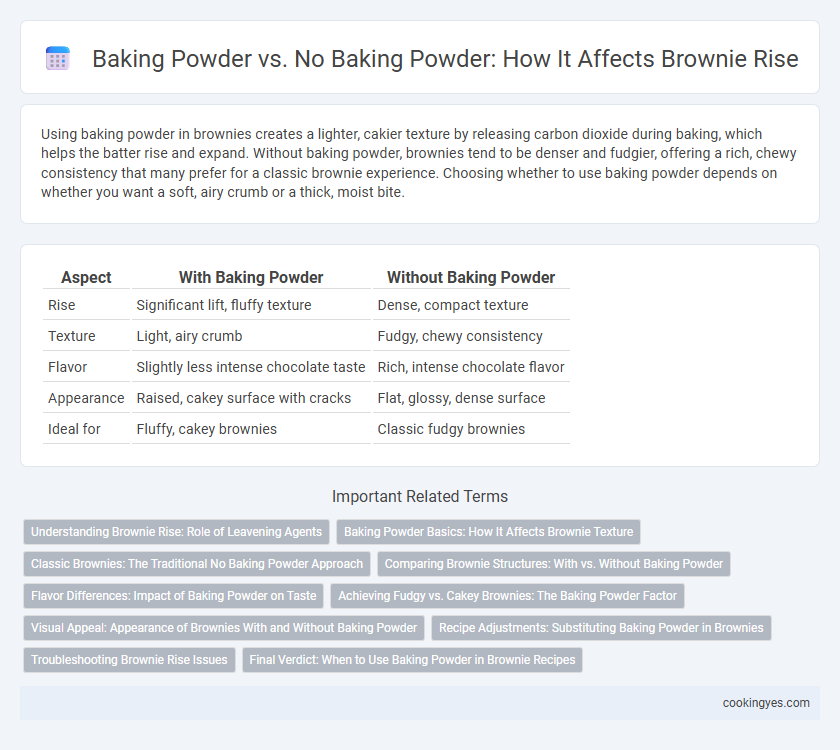Using baking powder in brownies creates a lighter, cakier texture by releasing carbon dioxide during baking, which helps the batter rise and expand. Without baking powder, brownies tend to be denser and fudgier, offering a rich, chewy consistency that many prefer for a classic brownie experience. Choosing whether to use baking powder depends on whether you want a soft, airy crumb or a thick, moist bite.
Table of Comparison
| Aspect | With Baking Powder | Without Baking Powder |
|---|---|---|
| Rise | Significant lift, fluffy texture | Dense, compact texture |
| Texture | Light, airy crumb | Fudgy, chewy consistency |
| Flavor | Slightly less intense chocolate taste | Rich, intense chocolate flavor |
| Appearance | Raised, cakey surface with cracks | Flat, glossy, dense surface |
| Ideal for | Fluffy, cakey brownies | Classic fudgy brownies |
Understanding Brownie Rise: Role of Leavening Agents
Baking powder plays a crucial role as a leavening agent in brownie recipes by producing carbon dioxide gas during baking, which helps the batter rise and results in a lighter, airier texture. Brownies made without baking powder tend to be denser and fudgier because they rely on eggs and butter for structure and moisture rather than chemical leavening. Understanding the impact of baking powder on brownie rise allows bakers to control texture, achieving either cakey or fudgy brownies based on ingredient proportions and mixing techniques.
Baking Powder Basics: How It Affects Brownie Texture
Baking powder acts as a chemical leavening agent that produces carbon dioxide gas when mixed with wet ingredients, creating bubbles that help brownies rise and develop a lighter, fluffier texture. Without baking powder, brownies tend to be denser, fudgier, and more compact due to the lack of leavening air pockets. Understanding the role of baking powder is essential to control the desired texture, whether aiming for cakey brownies with increased volume or rich, dense brownies with minimal rise.
Classic Brownies: The Traditional No Baking Powder Approach
Classic brownies traditionally rely on beaten eggs rather than baking powder for their rise, creating a dense and fudgy texture that defines their signature bite. Baking powder can introduce a lighter, cakier crumb, which contrasts with the characteristic chewiness of classic brownies. For an authentic taste and texture, skipping baking powder maintains the rich, moist consistency cherished in traditional recipes.
Comparing Brownie Structures: With vs. Without Baking Powder
Baking powder significantly affects brownie structure by creating a lighter, more cake-like texture with increased rise due to the release of carbon dioxide during baking. Brownies without baking powder tend to be denser and fudgier, offering a chewy consistency favored by many. The choice between using baking powder or not depends on the desired brownie texture, with baking powder promoting a tender crumb and absence enhancing moistness and richness.
Flavor Differences: Impact of Baking Powder on Taste
Baking powder in brownies creates a lighter, airier texture by promoting rise, but it can slightly alter the flavor, introducing a subtle tang or metallic undertone that affects the overall taste profile. Brownies without baking powder tend to have a denser, fudgier consistency, allowing the rich chocolate flavor to remain more intense and pronounced. Choosing whether to use baking powder depends on the desired balance between texture and the purity of chocolate flavor in the brownie.
Achieving Fudgy vs. Cakey Brownies: The Baking Powder Factor
Baking powder acts as a leavening agent that introduces air bubbles into brownie batter, resulting in a lighter, cakey texture with noticeable rise. Omitting baking powder produces denser, fudgier brownies by minimizing air pockets and moisture loss during baking. Understanding the impact of baking powder allows bakers to customize brownies, balancing between the rich, moist fudginess and the airy, tender cakey crumb.
Visual Appeal: Appearance of Brownies With and Without Baking Powder
Brownies made with baking powder exhibit a lighter, more aerated texture, resulting in a visibly puffier and cake-like rise with a golden-brown crust that enhances visual appeal. In contrast, brownies without baking powder maintain a denser, fudgier appearance, showcasing a glossy, smooth top and a compact crumb structure that appeals to those preferring a rich, chewy treat. The choice between using baking powder or not significantly influences the brownie's surface texture and overall thickness, affecting presentation and perceived freshness.
Recipe Adjustments: Substituting Baking Powder in Brownies
Substituting baking powder in brownie recipes affects texture and rise, requiring precise recipe adjustments to maintain density and moisture. Without baking powder, brownies tend to be denser and fudgier, while adding it introduces a lighter, cakier crumb by producing carbon dioxide during baking. To balance these effects, bakers often adjust ingredient ratios, such as increasing flour slightly or reducing fat and sugar, ensuring optimal rise and texture without compromising flavor.
Troubleshooting Brownie Rise Issues
Baking powder plays a crucial role in achieving a desirable rise and fluffy texture in brownies by releasing carbon dioxide during baking, which creates air pockets in the batter. Without baking powder, brownies tend to be denser and may not rise adequately, leading to a fudgy but flat consistency that can be mistaken for underbaking or ingredient imbalance. Troubleshooting brownie rise issues involves ensuring the correct amount of baking powder is used, checking the freshness of leavening agents, and accurately measuring ingredients to maintain the ideal chemical reaction for optimal texture.
Final Verdict: When to Use Baking Powder in Brownie Recipes
Baking powder is essential in brownie recipes when a lighter, cakier texture is desired, as it helps the batter rise by releasing carbon dioxide during baking. Without baking powder, brownies tend to be denser and fudgier, which is ideal for those preferring a chewy, compact bite. Use baking powder sparingly in recipes aiming for a balance between cakey and fudgy, ensuring optimal rise without compromising moisture.
Baking powder vs No baking powder for brownie rise Infographic

 cookingyes.com
cookingyes.com